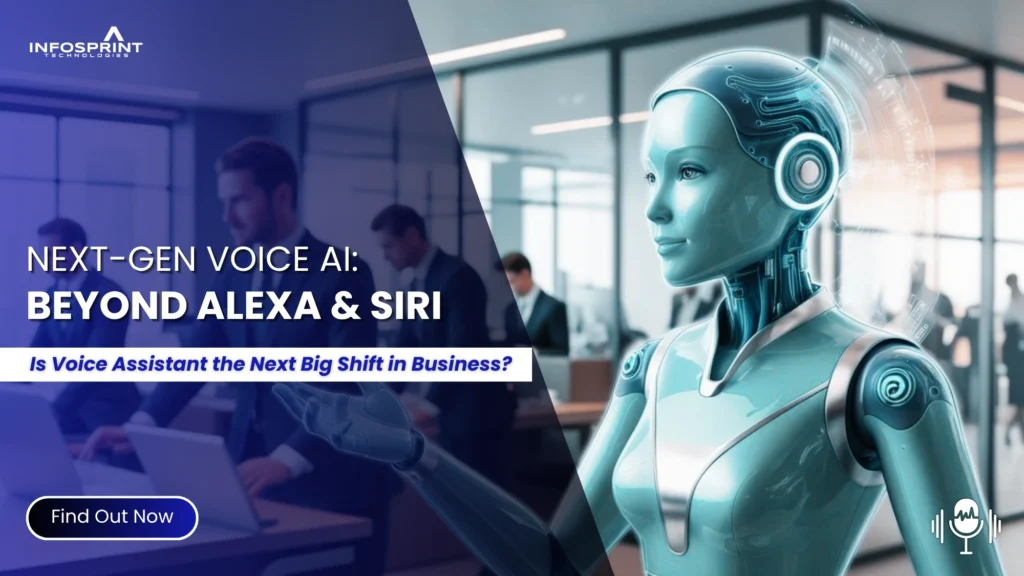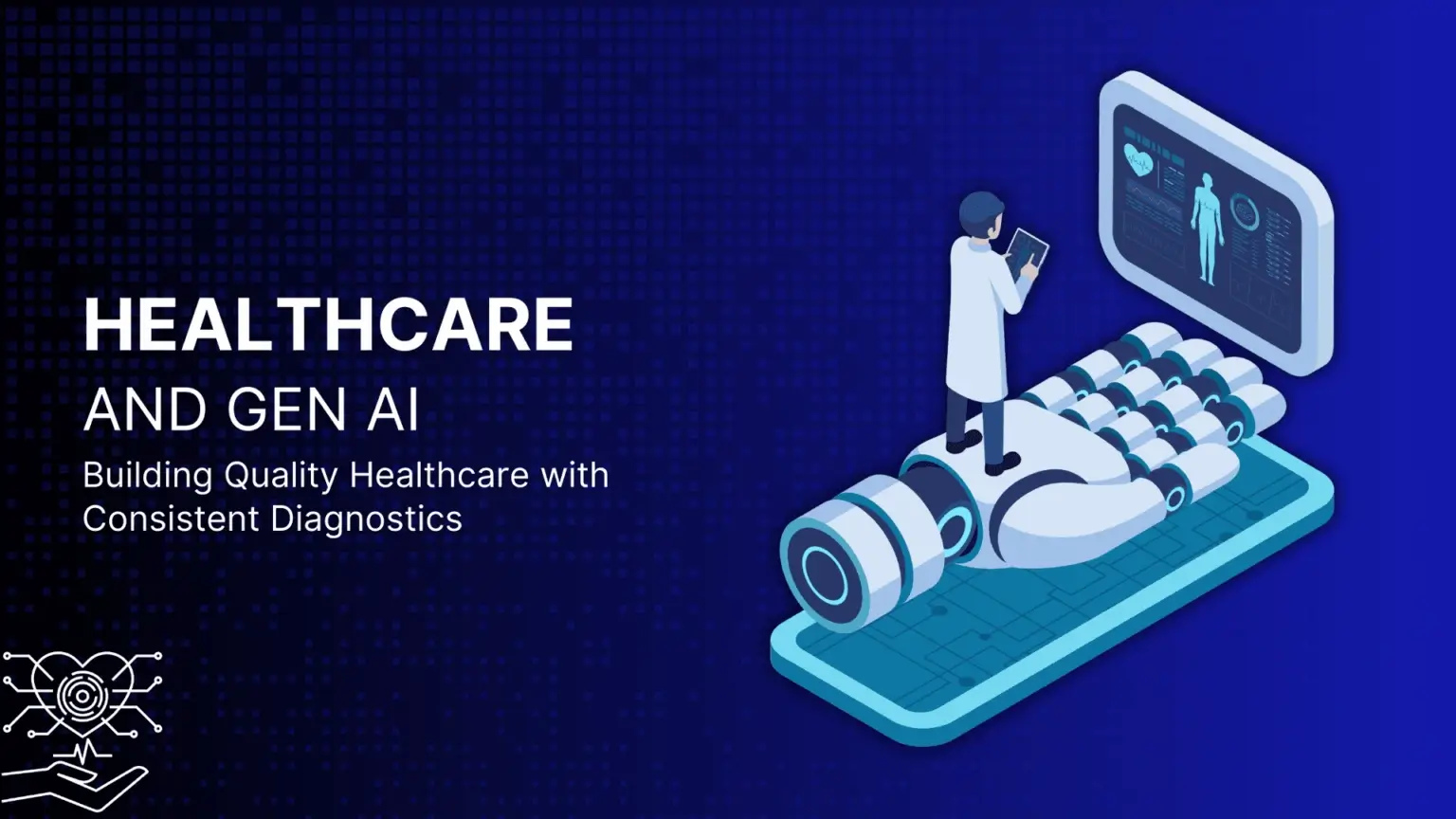Beyond Alexa & Siri: How Next-Gen Voice Assistants Are Reshaping Businesses

With 8.4 billion voice assistants worldwide, the real question isn’t whether you have one—it’s how well you’re leveraging its potential?
In today’s fast-paced digital landscape, businesses are turning to AI-driven voice technology not just for voice recognition but for intelligent automation, real-time insights, and seamless business integration.
However, to truly harness the power of voice assistants, businesses must adopt the right strategy and implementation approach. As a leading IT service company, Infosprint Technologies helps organizations integrate AI-driven solutions to streamline workflows, enhance customer interactions, and drive innovation.
In this blog, we’ll explore how next-gen voice assistants are redefining business operations, the key benefits they offer, and how businesses can maximize their potential for a competitive edge.
How Next-Gen Voice Assistants Are Transforming Business Operations
Next-gen voice assistants are evolving and transforming businesses at a rapid pace. They are used to communicate with customers, streamline workflow, improve productivity, and drive innovation for businesses to stay competitive.
1. Automating Routine Tasks
Efficiency is the key in today’s fast-paced world; voice assistants powered by AI offer a seamless way to automate routine tasks while reducing human error.
- Scheduling and calendar management: AI-powered assistants like Alexa, Cortana, and Google Assistant allow business professionals to schedule meetings, set reminders, and manage calendars with simple voice commands.
- Data entry and reporting: Voice assistants integrated with CRM systems like Hubspot, Salesforce, or Dynamics 365 can record customer details, update databases, and generate real-time reports.
- Task Delegation and workflow automation: Voice assistants integrated Using project management applications such as Monday.com, Asana, or Trello can streamline workflow management by delegating tasks through voice commands.
2. Customer Service and support
Customer satisfaction is key to business success, and AI-powered voice assistants help your business achieve it with faster and personalized services. However, handling high volumes of inquiries while delivering quick, personalized, and efficient support can be challenging. AI-powered voice assistants help businesses automate responses, personalize interactions, and optimize customer support operations, leading to faster resolutions, reduced workloads, and improved customer satisfaction.
▶️ 24/7 Customer support
- AI-powered assistants work round-the-clock, reducing wait times and improving accessibility.
- AI voice assistants integrate across websites, mobile apps, smart speakers, and phone systems. So the users can have their queries resolved from all types of devices with similar levels of expertise.
- Reduces operational expenses by handling high volumes of inquiries without increasing staff.
Example: A major e-commerce company Amazon has integrated a voice assistant into its customer service portal. When a customer inquires about their order status or return policies, the AI assistant provides real-time shipping updates and detailed return instructions, which reduces dependency on human agents.
▶️ Personalized customer interactions
- AI voice assistants use customer history, preferences, and sentiment analysis to provide contextual and personalized interactions.
- Recognizes returning customers and previous issues to provide relevant responses.
- Suggests products, services, or solutions based on past behavior.
- Detects tone and mood, adapting responses accordingly.
Example: Telecommunication providers, such as Airtel, have integrated Google Assistant to help customers with inquiries about billing and service upgrades. When a customer reports slow internet, the assistant analyzes previous complaints, provides a troubleshooting guide, conducts a real-time network check, and offers personalized upgrade suggestions.
▶️ Reducing Call Center Workloads
- Agents usually deal with complex and easy customer queries which leads to call fatigue, long resolve time, stagnant customers, and dissatisfied customers.
- AI voice assistants handle routine inquiries automatically, enabling human agents to concentrate on more important cases.
- Handles common queries like account balance checks, FAQs, and refund requests.
- Directs complex cases to the right department for faster resolution.
- Frees up agents for specialized customer interactions.
Example: Bank of America utilizes Erica, a voice AI assistant, for common customer queries such as balance checks, transaction histories, and loan inquiries. Instead of waiting on hold, customers receive real-time responses.
3. Optimizing Sales and Marketing Processes
Sales and marketing teams manage various tasks, such as lead generation and campaign execution. AI-powered voice assistants can streamline these processes, helping businesses work more efficiently and close deals faster. By automating lead management and providing voice-enabled analytics, these assistants improve productivity and enhance customer interactions.
▶️ Lead Management Automating Prospect Capture & Qualification
- Manually capturing leads is time-consuming and results in lost opportunities.
- AI voice assistants streamline lead capture by automating data collection, assessing lead quality, and updating CRM systems in real-time.
- Voice assistants gather contact details from calls, emails, and web forms.
- AI assesses lead intent based on voice interactions and past behaviors.
- Voice commands allow sales reps to update prospect details hands-free.
Example: LeadNXT uses lead IVR solutions focusing on voice technology to qualify & manage leads through an interactive voice response system.
▶️ Voice Powered Analytics
- Quick Data Retrieval: Sales reps can ask for revenue reports, conversion rates, or pipeline status.
- AI-Driven Recommendations: AI suggests sales strategies based on trends and historical data.
- Enhanced Forecasting: Voice assistants analyze past performance to predict future sales.
▶️ Marketing Campaign Assistance
- Voice assistance automation can schedule campaigns, track performances and send reminders for better campaign execution.
- It can automate campaign launches by scheduling them at optimal times ( when customers are likely to view the campaigns.)
- Voice assistants send reminders, track open rates, and analyze engagement.
- AI provides real-time updates on click-through rates, conversions, and ROI.
4. Improving Operational Efficiency in Enterprises
Voice assistants are transforming internal business operations, making enterprise workflows smarter, faster, and more efficient. In addition to enhancing customer interactions, AI-driven voice assistants aid businesses in streamlining inventory management, improving HR processes, and creating intelligent workspaces.
▶️ Inventory Management: Optimizing Supply Chain
- Managing inventory efficiently is crucial for retail, logistics, and manufacturing businesses. AI-powered voice assistants simplify stock tracking reducing human error and operational delays.
- Warehouse managers can use voice commands to check real-time inventory.
- AI generates purchase orders when stock levels fall below a specified threshold.
- Voice assistants deliver real-time updates on both incoming and outgoing shipments.
▶️ HR & Employee Management
- Voice assistants reduce the workload of HR managers by automating their routine tasks reducing manual effort and improving employee experience.
- AI guides new hires through company policies and setup processes.
- Employees get instant answers to HR-related questions (e.g., benefits, policies, mandates).
- Voice assistants process leave requests and track work hours.
Implementing Next-Gen Voice Assistants in Your Business
Step 1: Define Objectives and Use Cases
Before deploying a voice assistant, businesses must identify specific goals and areas where automation can bring the most value.
- Identify Key Business Functions: Determine whether the focus is on customer support, sales automation, HR assistance, or operational workflows.
- Assess Pain Points: Analyze repetitive tasks that can be automated, such as call handling, scheduling, or data entry.
- Set Clear Goals: Establish measurable objectives like reducing response times, improving lead conversion, or increasing workflow efficiency.
Step 2: Choose the Right Voice Assistant Technology
Various AI-powered voice assistant solutions are available, including Amazon Alexa for Business, Google Assistant, and enterprise-focused AI assistants. Choose a solution that aligns with your business needs.
- Evaluate Available Solutions: Amazon Alexa for Business, Google Assistant, Microsoft Cortana, and custom AI assistants tailored for enterprises.
- Ensure Industry Suitability: Choose a voice assistant that aligns with industry-specific needs, such as compliance in healthcare or multilingual support in e-commerce.
- Consider Scalability & Security: The solution should support business growth while ensuring data privacy, encryption, and compliance with regulatory standards.
Step 3: Integrate with Existing Systems
To ensure smooth implementation, voice assistants should be able to connect effortlessly with business applications and cloud platforms.
- Connect with Business Tools: For seamless operations, integrate voice assistants with CRM(Salesforce, Hubspot), ERP(Sap, oracle), HRM(Workday, BambooHR), and other business tools.
- Enable Cloud Connectivity: A cloud-based AI assistant enhances flexibility, allowing real-time access to business data.
- Ensure Cross-Platform Compatibility: The voice assistant should function across mobile apps, websites, and smart office devices.
Step 4: Train Employees and Optimize Workflows
Successful implementation requires training sessions for employees on using voice assistants effectively.
- Conduct Training Programs: Provide hands-on training sessions and documentation to employees on using AI assistants.
- Refine Workflows: Adapt existing processes to leverage automation—e.g., replacing manual scheduling with voice-activated calendar management.
- Encourage Adoption: Address employee concerns, highlight efficiency benefits, and monitor engagement to ensure widespread adoption.
Step 5: Monitor Performance and Improve Continuously
To maximize business efficiency regularly track the performance of voice assistants, analyze data insights, and make necessary improvements for optimal efficiency.
- Track Usage and Engagement: Monitor key metrics such as task completion rates, response accuracy, and user adoption levels.
- Gather Feedback and Insights: Collect input from employees and customers to identify usability issues or areas for enhancement.
- Implement Regular Updates: AI assistants should be continuously optimized with new functionalities, bug fixes, and workflow improvements.
Future Trends in AI-Powered Voice Assistants
The future of voice assistants is promising, with advancements in AI and automation set to drive innovation in business operations. Some emerging trends include:
- AI-Powered Conversational Intelligence: Future voice assistants will be capable of understanding emotions, tone, and context for more natural interactions.
- Voice Commerce Growth: Businesses will leverage voice assistants for seamless voice-enabled shopping experiences.
- Integration with IoT: AI voice assistants will be integrated with IoT devices for bright office and home automation.
- Multilingual and Regional Adaptations: AI advancements will enable voice assistants to cater to global markets with multi-language support.
Are You Ready for Voice?
Next-generation voice assistants are transforming the way businesses operate by automating tasks, optimizing processes, and enhancing customer experiences. By utilizing AI-powered voice technology, organizations can increase productivity, improve operational efficiency, and stimulate growth.
As natural language processing (NLP) and artificial intelligence (AI) continue to develop, companies that use voice assistants Technology will increase its market competitiveness.
- Customer service
- Sales automation
- Workflow optimization
Integrating next-gen voice assistants is essential for smarter business operations in the digital age.
Discover how Infosprint Technologies can help your business integrate AI-powered voice assistants seamlessly. Let’s talk!
Related Posts

Top 10 Cloud Computing Technologies to Look Out for in 2025





